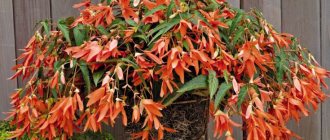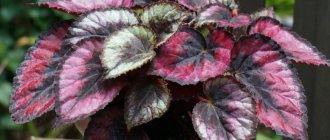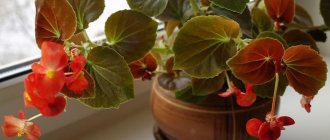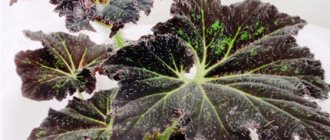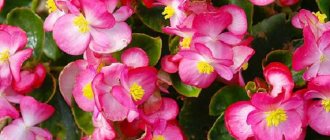Today we’ll talk about how to care for royal begonia at home. The beauty of this truly royal flower is breathtaking, and one can talk about the usefulness of the plant for hours. Begonia with large pointed leaves cleanses the air of harmful impurities, attracts well-being into the house, imparts self-confidence, etc.
Briefly about care
| Type of agricultural operation for caring for Rex begonia | Description of conditions and actions |
| Watering and air humidity | Watering at the root, not very abundant; from spring to autumn - up to 4 times a week (as the top layer of soil dries); In winter, watering is reduced. There is no need to spray; the casting should be wiped periodically with a damp cloth. High humidity required |
| Lighting organization | Diffused sunlight, partial shade in winter requires artificial lighting in summer needs shading |
| Maintaining a rest period | October to March (some species do not hibernate) |
| Creating temperature conditions | From +17 to +25 °C afraid of drafts and low temperatures; rest period not lower than +16 °C |
| Trimming | The first pruning is carried out when the plant height is 10–12 cm; during the flowering period, peduncles that deplete the begonia are removed |
| Making soil mixture | Nutritious, loose, moderately acidic soil mixture of peat, sand, leaf and turf soil (1:1:2:1) You can add vermiculite or pine bark |
| Fertilizer application | Once a month in the spring, nitrogen-containing mineral fertilizers are applied, and in the summer, phosphorus-potassium compounds are applied. Mineral fertilizers should be alternated with organic matter: 200 g of cow manure per 1 liter of water, and do not feed in winter |
| Transfer | Replant annually after dormancy, rejuvenate every 3–4 years |
| Chemical treatment | Insecticides: aphids, poutine mites, greenhouse whiteflies, soft scale insects, thrips; fungicides: gray mold, powdery mildew, bacterial spot, ring spot |
Photo gallery
tsvetochnyy_blyuz
tsvetochnyy_blyuz
marinavlmk__
irina_fialki74
olivka.de
olgamakarovaizorla
amaryllis_blog
bilyknata7
Description of the plant
Royal begonia, also known as Begonia Rex, is a hybrid variety of the Elatior group, bred by crossing Socotrans and tuberous begonias. Perhaps this is the most beautiful and original flower in the world, deservedly called royal. Almost all of its varieties have asymmetrical carved leaves ranging from bronze-chocolate, almost black, to cherry-red with a luxurious silvery sheen.
Royal Begonia Rex
Due to the heart-shaped base and sharp edge of the leaves, the royal begonia is also called “Napoleon’s Ear”, “Elephant Ears”. The surface of the leaf blade is velvety, slightly pimply, covered with short villi. The back side is covered with red veins.
By crossing Rex begonia with other varieties, unusual hybrids with fringed or spiral-shaped foliage were formed.
A rather large, dense creeping rhizome protrudes above the surface of the ground. After the lower leaf plates dry out, marks remain on the rhizome.
In nature, the herbaceous perennial grows in the tropical forests and mountains of Eastern India. We grow it exclusively at home. In order for an exotic beauty to fully develop, she needs to be provided with conditions as close as possible to the humid climate of her historical homeland.
Flowering is sparse, flowers are small and not particularly attractive. They are not the main decoration of the plant, since they are significantly less decorative than the leaves.
Royal begonia blooming
It is impossible to convey all the charm and versatility of Rex begonia from a photo. In fact, the tropical plant is much more beautiful.
Helpful information! The fleecy leaves of the royal begonia purify the indoor air from germs and dust. Therefore, the plant needs regular wet cleaning, at least 2 times a month. Gently wipe each leaf with a damp flannel cloth. Do not forget about the fragility of the tropical guest and that it can break from any careless movement.
Popular varieties and hybrids of royal begonia
Among the variety of varieties and hybrids of royal begonia, you can get confused. Moreover, each individual variety is unique in its own way. We present to your attention the most interesting plants suitable for growing indoors:
Mini Mary Christmas
Begonia "Mini Merry Christmas" (B. Mini Merry Christmas) is the most variegated variety of royal begonia, growing up to 30 cm in length. From the brown center of the leaf blade, bright green spills out, turning into a wide red-crimson border. The entire surface is strewn with bright pearlescent specks. The top of the leaf is velvety, the back is cut with large veins.
Begonia mini merry christmas
Griffon
The tallest and longest lasting royal begonia (B. Griffon) is often used in landscape design. In this case, the shrub is grown as an annual. In the home flower garden, it is a perennial with a height of up to 41 cm. Large white-green leaves with dark veins calmly tolerate dry air (which cannot be said about the parent of the hybrid).
Royal begonia griffon
Escargot
Because of the bizarre shape of its leaves, the Escargot begonia (B. Escargot) is called the “royal snail.” A rather wide bush, 30 cm high, consists of large matte fleecy leaves, twisted at the base into a double spiral. A curved silver stripe runs through the dark olive base of each leaf, separating the center from the edge.
Exotic beauty
The plant deservedly bears the name “royal”. Its luxurious large leaves with jagged edges and long stems stand out with their bright colors. Depending on the variety, it may be interspersed with crimson, red, silver or purple stripes. They are shaped like elephant ears or a slightly distorted heart.
Begonia royal
Important! In length, begonia bushes grow up to forty centimeters, and the height of mini-shrubs of this species is no more than fifteen.
What is important to know before purchasing
In a series of decorative foliage plants, Rex begonia is the queen, which has no competitors in brightness and originality. It is readily grown by experienced gardeners and beginners, captivated by the unpretentiousness of the tropical beauty. If you also want a plant for your home flower garden, first read the following table:
| Mature plant size | From 15 to 40 cm in height, leaf size up to 30 cm, the width of some specimens reaches 45 cm |
| Lifespan | Up to 10 years or more |
| Bloom | Blooms; flowers pink, pale pink, white, beige |
| Aroma | Without smell |
| Safety | Not poisonous |
| Difficulty of care | Unpretentious plant |
| Uniqueness | Common type |
| Where can I buy |
The highly titled plant differs from its “relatives” by its amazing brightness, regardless of flowering. Begonia Rex may not bloom at all and will only benefit from this. The fact is that inconspicuous buds deprive the plant of its vitality and, in order to preserve the decorative appearance of the leaves, experienced gardeners cut off the flowers.
Interesting fact! Begonia Rex is the flower of businessmen. By placing a houseplant in your office, you can rest assured that it will protect you from rash actions and help you find the only right solution.
Kinds
There are many varieties of Rex begonia. All these subspecies can be divided into:
- leafy;
- tuberous;
- bush.
The first is ideal for keeping indoors. Tuberous feels great outdoors. The bush blooms the longest.
Spare no time and effort and get a Rex begonia in your apartment. You will be pleasantly surprised by the unusual shape and bright colors of the plant’s leaves. If you take proper care of the royal flower, it will invariably delight you with its splendor and beauty.
Recommendations from an expert: rejuvenate correctly
Royal begonia is replanted every spring. An equally important procedure is plant rejuvenation, which is carried out every 3-4 years. With the right approach, you can significantly increase the life of a plant and grow a young bush from a mother cutting.
No, we will not rewrite information that is repeated many times on various sites. We better use the experience of knowledgeable flower growers Pavel and Elena Enikeev, who have been leading the YouTube channel since 2009.
Rejuvenation of the royal begonia Lilian
The royal variety Lilian is used as an example. The rejuvenation procedure consists of several stages:
- Removing fresh and old flower stalks. Old ones fall off at the slightest touch, fresh ones are cut off with sterile sharp scissors.
- Inspecting the plant and soil in the flower pot for dry leaves. Remove them also mercilessly, as they can be carriers of all sorts of diseases.
- Removing plant leaves with spots and other signs of illness. They should easily lag behind the bush. Such leaves should be thrown away immediately and not used to propagate begonias.
- Removing low-growing leaves, if any (applies to plants with elongated stems that will have to be buried when transplanting). These leaves can and should even be used to produce young plants.
- Removing a plant from a flower pot. A healthy begonia has white roots. If the soil is moist, the roots take on a yellowish tint.
- Preparing a new pot. It should be larger in diameter than before. If the begonia grew in a 12 cm container, it should be transplanted into a 15 cm container.
- Trimming soil penetrated by the root system. You can simply unscrew and tear off half of the substrate-root mass with your hands. The top layer should be left for better survival of the plant in the new container.
- Preparation of a soil mixture from leaf soil, turf soil, peat, river sand (2:1:1:1) and a small amount of crushed coniferous tree bark.
- Planting begonias. Deepen the bush to the level of the lower leaves, fill all the voids with substrate, and tamp lightly. To prevent the plant from staggering, the trunk circle must be pressed with your fingers.
Possible problems
Of all the diseases of indoor flowers, begonia most often suffers from all kinds of rot and powdery mildew. The reason for this is usually improper care - keeping it in a cold room and abundant irrigation. The disease is expressed by the appearance of darkened soft areas on the stem and leaf blades. When the root system is damaged, the leaves become covered with brown spots. If powdery mildew develops, the entire surface of the flower becomes covered with whitish spots.
Read an interesting article about the Yucca filamentous flower.
If the disease spreads to the root, it is impossible to save the flower. If the above-ground part is affected, remove all infected leaves and stems. The bush itself is treated with Fitosporin or Bordeaux mixture. The drugs are diluted with water according to the instructions.
Harmful insects that attack begonias become attached to the underside of the leaves. Aphids can be seen with the naked eye. Spider mites are recognized by their characteristic cobwebs and yellow spots - traces of insect activity. Begonia is also affected by the mealybug, which looks like a small white insect.
Modern insecticides successfully fight all pests. The preparations are diluted according to the instructions on the packaging and the bushes are treated twice.
How to propagate
Reproduction is not as labor-intensive a process as it might seem at first. First of all, decide for yourself which method of obtaining a new bush is right for you, thoroughly study the sequence, features of the technological process and start acting.
Cuttings are the most win-win and popular propagation option for any type of begonia, including royal ones. Cut a piece of the trunk with leaves, place the cut side in water and after 3 weeks plant the young roots in the substrate. The same method is excellent for rejuvenating a plant by separating a large cutting. If you decide to use it, remember that in this case the mother plant will lose its decorative effect.
It is easy to propagate begonia using a leaf. Place the cut leaf in water (the length of the stem is no more than 2 cm). After a couple of weeks, when the roots appear, place the leaf in the substrate and cover with film. As soon as a young sprout appears from the center of the leaf blade, deepen the planting to the growth point. The mother leaf will begin to wither, but you cannot cut it off (it becomes a source of nutrients for the baby).
Some leaves produce babies not only from the center of the convergence of the veins, but also from the leaf stalk-petiole. Young shoots easily pass through loose soil and with a 100% probability quickly grow into a strong young plant.
The bright leaves of the royal begonia have extremely pronounced veins. They can also be used to grow new plants:
- Take a leaf with a stem shortened to 1 cm and place it in warm water.
- Having noticed the first roots, make cuts on the back side of the leaf, where the veins are especially noticeable (1-2 for each vein). Do not cut the vein all the way through, just make a snip.
- Lubricate each cut with cytokinin ointment (100% guarantee of germination).
- Bury the cutting with roots into the substrate at an angle, so that the leaf takes a horizontal position (you can press the plate to the ground with small pebbles).
After some time, children will appear. They will come out from the center of the leaf, petiole, and cut veins. This method allows you to get from 5 to 8 new bushes at the same time. But such children grow too slowly, so most gardeners propagate Rex begonia by leaves and cuttings.
If you want to grow a “queen” with seeds, be prepared for the fact that during the process of flowering and ripening of the seed pods, the mother plant will lose its decorative effect. Moreover, the result of seed propagation of hybrid varieties does not always meet expectations.
Expert Advice: Mistakes When Reproducing
The Enikeev couple have been running their family project for more than 10 years - a YouTube channel, where they clearly talk about ways to grow all kinds of plants. Today Pavel and Elena will talk about what mistakes are made when propagating decorative deciduous begonias:
- Using the wrong substrate. Substrate is the most important thing when growing plants. A common mistake made by novice flower growers who purchase store-bought soil for begonias. If you don’t want to bother with making a soil mixture, preferring to buy ready-made soil, look for a professional mixture. It is sold in large bags of 150, 200 or 300 kg. But some sites offer smaller packages.
- The blade of the device for cutting cuttings, leaves, or dividing the leaf into fragments is not sharp or thin enough. For some reason, some gardeners use old scissors or serrated knives to work with plants. Such devices crush leaf cells and contribute to their decay.
- Temperature too high. Don't think that babies need heat. The optimal temperature for the development of young plants is +20+24C. Even +25C is a critical indicator leading to illness and death of begonia. It’s not so scary if the temperature drops to +18C. A little cooler is better than hotter.
- Insufficient lighting. By placing beautiful adult plants in the most illuminated place, and pushing greenhouses with fragments into shade or partial shade, people doom the sprouts to death. Young plants get their energy from light. Otherwise, roots will not form, and the development of cuttings will freeze.
- Overwatering. When planting a leaf, the soil does not need to be compacted. Let there be an air cushion between its layers. Watering should be done moderately so that water does not stagnate in the soil. Otherwise, the children will die and the roots will rot.
Each of the above factors is equally detrimental to future begonia. Therefore, it is very important to study possible mistakes and avoid them when growing new plants.
Wintering of the Royal Begonia
When planting and breeding royal begonia at home, competent care is required, without disturbing the watering regime, lack of lighting or cold drafts. It is equally important to provide the deciduous ornamental plant with a full winter.
Royal begonia does not have a pronounced dormant period and develops equally well in summer and winter. But from mid-autumn, when daylight hours are shortening, you should stop fertilizing and reconsider the watering regime (receiving the summer portion of moisture and not receiving enough light, the bushes will begin to stretch, thin out, and become deformed). Therefore, from mid-October, the growth of the plant must be slowed down by reducing watering and lowering the temperature to 16 C. Water the begonia after the top layer of soil in the pot has dried 3 cm. Otherwise, the roots will rot.
Features of the winter period:
- decrease in temperature and poor watering, otherwise the root system will begin to rot;
- decrease in temperature and wet leaves, otherwise the begonia will be affected by the fungus;
- heat and dry air can cause leaves to dry out;
- winter transplantation will cause the plant to get sick;
- cuttings cut during this period will most likely rot.

